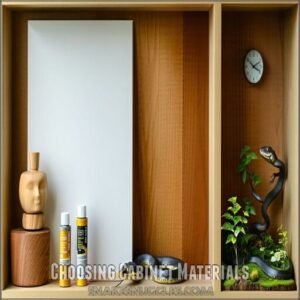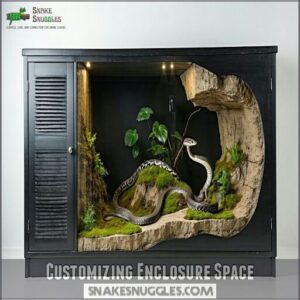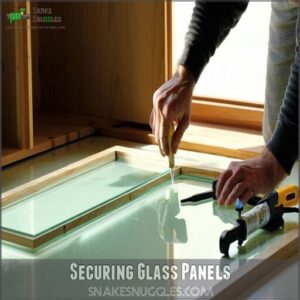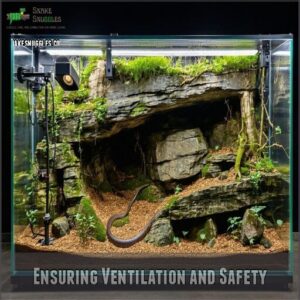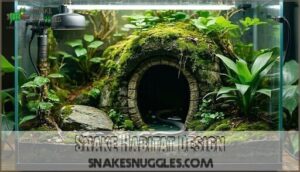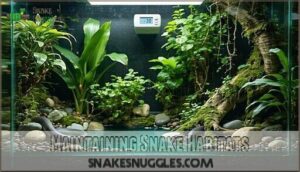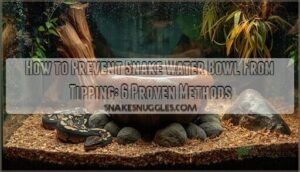This site is supported by our readers. We may earn a commission, at no cost to you, if you purchase through links.
 Creating an ideal DIY snake habitat starts with choosing the right enclosure—wood, PVC, or glass cabinets work well.
Creating an ideal DIY snake habitat starts with choosing the right enclosure—wood, PVC, or glass cabinets work well.
Customize the size to match your snake’s species, ensuring room to stretch, hide, and explore. Add a secure sliding glass panel for visibility and easy access.
Include proper ventilation to avoid stale air, and keep safety in mind by sealing gaps to prevent escape.
For design, create warm and cool zones using heat pads or lamps, and add a reptile-safe substrate, natural decor, and hides. Think of it as setting up the ultimate snake spa—functional and fabulous!
Ready to level up? Stay tuned.
Table Of Contents
- Key Takeaways
- Building Snake Enclosures
- Snake Habitat Design
- DIY Snake Board Ideas
- Maintaining Snake Habitats
- Upgrading Snake Enclosures
- Frequently Asked Questions (FAQs)
- How to create a snake habitat?
- What is the best material for snake enclosures?
- What not to put in a snake enclosure?
- What is the best habitat for snakes?
- How do I create an ideal snake habitat?
- Can you make a snake hide at home?
- How do you make a home for a pet snake?
- How do you build a snake enclosure?
- What can I make a snake enclosure out of?
- What makes a good snake habitat?
- Conclusion
Key Takeaways
- Start with a sturdy enclosure like a converted cabinet, adding tempered glass doors and proper sealing for security.
- Use non-toxic materials like vinyl flooring and coconut husk substrate to create a safe and durable environment.
- Include essential features like hides, climbing structures, and separate warm and cool zones to mimic your snake’s natural habitat.
- Regularly clean, monitor humidity and temperatures, and observe your snake’s behavior to ensure their health and comfort.
Building Snake Enclosures
You can build a custom snake enclosure that’s safe, functional, and perfectly suited to your pet’s needs.
By using sturdy materials, secure panels, and proper ventilation, you’ll create a habitat that looks great and keeps your snake healthy.
Craft a cozy, ventilated snake habitat with sturdy materials and secure panels to ensure your scaly friend thrives in style.
Choosing Cabinet Materials
When selecting materials for cabinet conversion, consider moisture resistance and wood toxicity to protect your snake.
Look for durability and affordability while boosting your furniture restoration skills.
- Melamine resists water but needs sealing.
- MDF is cheap but dust-prone.
- Hardboard offers structural integrity at a low cost.
- Choose wood for aesthetic appeal.
- Make safety a priority with non-toxic adhesives.
Consider purchasing cabinet refacing supplies for your project to ensure a successful cabinet conversion.
Customizing Enclosure Space
Rotating cabinets on their side maximizes vertical space, letting you fit bins or custom snake habitats easily. Remove flimsy back panels and fixed shelves, then add hardboard for support.
Use vinyl flooring for burrowing opportunities and substrate variety. Proper ventilation helps prevent common respiratory problems in snakes.
Here’s a quick guide:
| Task | Materials Needed | Key Benefit |
|---|---|---|
| Replace back panel | Hardboard, adhesive | Structural stability |
| Add flooring | Vinyl, GE Silicone I | Easy cleaning, durability |
| Customize layout | Shelf supports, tools | Snake enrichment ideas |
This creates a functional, stylish DIY snake enclosure!
Securing Glass Panels
Once your cabinet is ready, it’s time to tackle the glass snake enclosure.
Use aquarium-safe adhesives like GE Silicone I to secure track materials for glass installation. Verify the glass thickness fits snugly in the tracks for smooth panel removal.
For reliable sealing, consider using products designed for aquatic environments.
Add silicone sealing to prevent moisture issues, then include safety latches to stop clever snakes from sneaking out.
Ensuring Ventilation and Safety
Good airflow design is key for snake cage ventilation, keeping your pet comfy and healthy.
Guarantee reptile cage safety with secure mesh panels or vent holes. Here’s how:
- Use non-toxic screens to prevent escape and maintain humidity control.
- Keep electrical safety in mind—position wires safely.
- Test your DIY snake habitat setup thoroughly for durability and leaks.
The importance of following these steps lies in ensuring reptile cage safety and the well-being of your pet.
Snake Habitat Design
Designing a snake habitat means creating the perfect environment that balances safety, comfort, and your snake’s natural behaviors.
Creating a snake habitat is about blending safety, comfort, and natural design for a thriving, happy reptile.
With the right size, temperature, and features like hides and climbing spots, you can make a space your snake will thrive in.
Determining Enclosure Size
Before finalizing your snake enclosure design, match the space requirements to your snake’s length and activity level.
Snakes need room to stretch, explore, and thrive, so choose an enclosure shape that fits their natural behavior.
Plan for future growth; a young snake’s tiny size can fool you!
A well-thought-out snake habitat design guarantees both comfort and safety for your reptile.
Creating Temperature Gradients
Heat placement is key to creating a snake habitat with proper temperature regulation.
Use a thermostat to calibrate precise gradients, ensuring the warm side reaches species-specific needs. Measure with thermometers or temperature guns to avoid overheating.
Radiant heat panels work well for heat and humidity control. Adjust seasonally to maintain comfort—like fine-tuning your snake’s personal thermostat!
Maintaining the correct temperature is essential for a snake’s well-being.
Adding Substrate and Decor
To enhance your snake’s habitat, start with a safe substrate like coconut husk or cypress mulch—it’s soft and mimics nature.
Add terrarium decor, including sanitized driftwood and stones, to boost visual appeal. Incorporate natural materials for a more naturalistic design.
Selecting the right material impacts snake habitat quality. Be creative with decor sanitation and enrichment variety, ensuring everything’s cleaned and snake-safe.
Keep it stylish yet functional!
Incorporating Hides and Climbing Structures
Hides and climbing structures are essential for a naturalistic snake setup.
Use safe materials like cork bark for hides and branches for climbing angles.
Size-appropriateness matters—snakes should fit snugly in hides without feeling cramped.
Sprinkle in enrichment variety by adding a snake jungle gym or textured objects.
Keep hide placement strategic, balancing access and security within your snake enclosure DIY project.
DIY Snake Board Ideas
Building a snake board is a fun way to give your scaly friend more climbing and sensory opportunities outside their enclosure.
With the right materials and a little planning, you can create a safe, sturdy setup that encourages natural behaviors like exploring and balancing.
Materials and Construction
Choosing snug materials is key for snake enclosure construction.
Hardwood or melamine guarantees joint strength, while tempered glass with proper thickness boosts visibility and safety.
Use safe sealants, like GE Silicone I, for secure edges.
Vinyl flooring options simplify cleaning and fit well in reptile habitats.
Follow a reptile enclosure materials list to avoid mistakes and build your snake’s dream home!
Textured Surfaces and Enrichment
Enrichment variety boosts your reptile habitat by stimulating natural behaviors.
Add textured surfaces for sensory stimulation.
Use these ideas:
- Attach netting or shelf liner to climbing structures for grip.
- Scatter sanitized rocks or cork bark for environmental enrichment.
- Create a behavioral enrichment zone with mazes using plastic tubes and sacks.
Providing secure hiding spots alleviates stress.
Watch your snake explore with newfound curiosity!
Safety Considerations and Handling
When working with snakes, safety is key.
Use non-toxic materials to avoid poisoning risks.
Always secure lids and gaps to prevent escapes—your snake’s a sneaky genius!
Practice safe handling to minimize bite risks, and keep calm if startled.
Plan for emergencies with basic veterinary care contacts and health monitoring tools.
Reptile safety starts with your careful preparation and attention.
Customization and Scalability
When it’s time to personalize your snake board, think modular enclosures and adaptable designs.
Build an expandable habitat that grows with your snake. Stackable systems save space while adding layers of enrichment. Future-proofing guarantees long-term usability without extra builds.
- Focus on stackable designs for vertical space.
- Incorporate adjustable components for flexibility.
- Use lightweight materials for easy upgrades.
- Plan extra room for snake growth.
Maintaining Snake Habitats
Keeping your snake’s habitat clean, safe, and comfortable isn’t just a chore—it’s essential for their health and happiness.
You’ll need to monitor temperature and humidity, spot clean regularly, and watch for signs that your scaly friend is thriving.
Cleaning and Disinfecting
Good snake care means keeping their habitat spotless. Clean your reptile enclosure weekly by replacing the substrate, scrubbing surfaces with safe disinfectants, and washing the water bowl to maintain hygiene.
Prevent mites and odors by addressing corners and crevices. Here’s a quick guide:
| Task | Frequency | Tools Needed |
|---|---|---|
| Substrate replacement | Weekly | Gloves, trash bag |
| Water bowl hygiene | Daily | Dish soap, sponge |
| Odor control | Weekly | Safe disinfectant |
The table outlines the necessary tasks for maintaining a clean and healthy environment, including substrate replacement, water bowl hygiene, and odor control to ensure the well-being of your snake.
Monitoring Temperature and Humidity
Set up a thermometer and hygrometer for precise sensor calibration. Proper thermostat placement guarantees your radiant heat panel keeps the reptile enclosure cozy.
Monitor gradient temperatures with data logging to balance snake care needs. For humidity control, use misting or bowls.
Humidity management doesn’t have to be tricky—just keep an eye on levels to keep things perfect!
Observing Snake Behavior and Health
After tracking temperature and humidity, focus on snake behavior to assess reptile health.
Watch shedding patterns—uneven sheds might signal issues. Observe feeding responses and activity levels; sluggishness could mean trouble.
Check scale condition for injuries or discoloration. Listen for respiratory signs like wheezing.
A watchful eye in the snake habitat guarantees proper snake care and a thriving enclosure.
Practicing Quarantine and Emergency Procedures
Spot unusual snake behaviors early with sharp observation—your pet’s survival could hinge on it.
Build a solid Quarantine Setup: dedicate a separate reptile enclosure and equipment in isolation.
Stock Emergency Supplies—nitrile gloves, antiseptics, and Vet Contact info.
Practice Safe Handling with new arrivals to prevent cross-contamination.
Strong isolation protocols keep your animal habitats drama-free, making reptile care manageable, not chaotic.
Upgrading Snake Enclosures
Upgrading your snake’s enclosure means tailoring it to their growth, activity level, and natural instincts.
By rethinking layout and adding features like hides, climbing structures, and secure decor, you’ll create a space that’s both functional and engaging.
Assessing Snake Growth and Needs
Snakes grow, and their needs shift over time.
Watch for shedding frequency, feeding schedules, and behavioral changes—they can signal your reptile enclosure is too small or lacks proper enhancements.
Health indicators like weight or scale issues might point to upgrades.
By tailoring your enclosure size and habitat design, you’re not just keeping a pet, you’re creating a personalized, thriving ecosystem with a focus on ecosystem.
Modifying Enclosure Layout and Features
Your snake’s home should evolve as they grow. Modify the layout to enhance comfort and functionality.
- Add vertical space for climbing and exploring.
- Create burrowing opportunities with deep, soft substrate.
- Incorporate separate feeding stations to keep things tidy.
- Upgrade with gentle water features for hydration.
- Experiment with lighting schemes to mimic natural conditions.
Consider optimal tank dimensions for your snake’s comfort. These upgrades will enrich their behavior and health!
Adding New Decor and Accessories
Freshen up your snake’s home with snake decor that’s both safe and functional.
Add climbing options like sanitized branches for muscle-building fun or hiding spots using upcycled containers.
For enrichment variety, try creative snake hide ideas or handmade snake habitat furniture.
Choose DIY decor ideas that balance visual appeal with functionality, ensuring a stylish, enriching space your snake will love.
Ensuring Safety and Security During Renovations
When upgrading your snake enclosure setup, focus on escape prevention and secure construction.
Double-check locks and reinforce weak spots. Glass handling needs steady hands—tempered glass reduces break risks.
Use non-toxic materials to avoid harming your snake. Keep wires tucked away for electrical safety.
Smart snake habitat design keeps your snake safe, blending function with creativity in your reptile enclosure ideas, ensuring a safe environment.
Frequently Asked Questions (FAQs)
How to create a snake habitat?
Transform a sturdy cabinet or shelving unit by adding tempered glass doors, vinyl flooring, and silicone-sealed edges.
Enhance with heat mats, climbing features, and natural decor for a functional, snake-friendly habitat that’s easy to maintain.
What is the best material for snake enclosures?
Think of enclosures as castles for your snake—PVC or melamine are top choices.
They’re durable, easy to clean, and hold heat well.
Avoid wood unless sealed; moisture can warp it and invite bacteria.
What not to put in a snake enclosure?
Avoid scented substrates, sharp decorations, heat rocks, cedar or pine bedding, and non-secured items.
Skip small, tight mesh that snakes can get stuck in.
Never add anything toxic, abrasive, or overly reflective—snakes thrive in calm, natural settings.
What is the best habitat for snakes?
The best snake habitat mimics their natural environment—warm, humid, and secure.
Use non-toxic materials, provide hides, climbing branches, and a water bowl.
Include heat sources and substrates like coconut husk for comfort and easy maintenance.
How do I create an ideal snake habitat?
Build an ideal snake habitat by combining safety, creativity, and function.
Use a sturdy enclosure, add non-toxic materials like vinyl flooring, regulate heat and humidity with thermostats.
Include hides, climbing spots, and enrichment objects.
Can you make a snake hide at home?
Over 70% of snakes use hides daily for security.
You can craft one at home with a plastic container, cut an entry hole, smooth edges, and add coconut husk bedding inside—simple, cozy, and snake-approved!
How do you make a home for a pet snake?
Creating a snake home starts with a secure enclosure like a converted cabinet.
Add proper heating, non-toxic bedding, and hides.
Include climbing branches or rocks for enrichment, ensuring it’s escape-proof and easy to clean.
How do you build a snake enclosure?
Start with a sturdy cabinet or shelving unit, flip it on its side for stability, and remove unnecessary panels.
Add non-toxic vinyl flooring, tempered glass doors, and secure heat sources.
Seal seams to prevent moisture damage.
What can I make a snake enclosure out of?
Imagine a sturdy old cabinet transformed into a reptile haven.
You can repurpose shelves, tempered glass, vinyl flooring, and non-toxic silicone to create a safe, cozy, and durable snake enclosure with endless customization options.
What makes a good snake habitat?
A good snake habitat balances safety, comfort, and enrichment.
Use escape-proof enclosures, proper heating, and humidity levels.
Add hides, climbing structures, and non-toxic decor. Think cozy cave meets jungle gym—snake-approved and easy to maintain!
Conclusion
Transforming your snake’s space into a dream habitat doesn’t have to be a tall order—it just takes thoughtful planning and a touch of creativity.
By exploring these DIY snake habitat ideas, you’re giving your scaly friend a safe, cozy environment and also crafting a functional and fabulous enclosure that’s easy to maintain.
Remember, the right mix of comfort, enrichment, and security leads to a happy, healthy snake. Get started and let your reptile thrive!
- https://therepstylist.wordpress.com/2020/04/01/creating-a-temperature-gradient/
- https://familysnake.com/guides/mastering-the-art-of-temperature-control-in-your-snakes-habitat/
- https://ball-pythons.net/forums/showthread.php?236337-Temperature-gradient-and-heat-sources-the-never-ending-headache!
- https://www.reddit.com/r/cornsnakes/comments/1e5jrko/help_with_achieving_a_proper_temperature_gradient/
- https://community.morphmarket.com/t/best-methods-for-keeping-a-good-temperature-with-gradient-in-a-tiny-bin/29416

